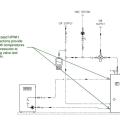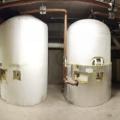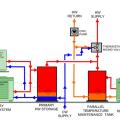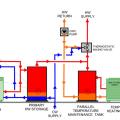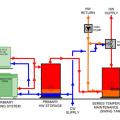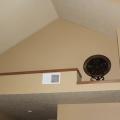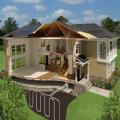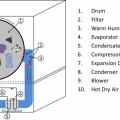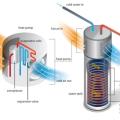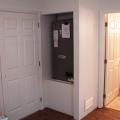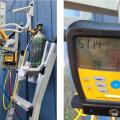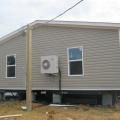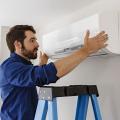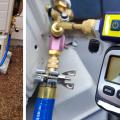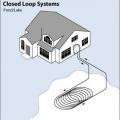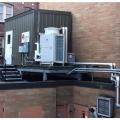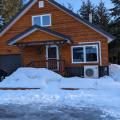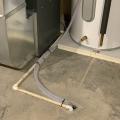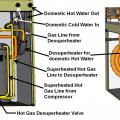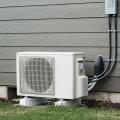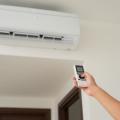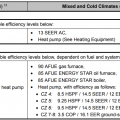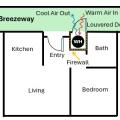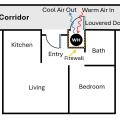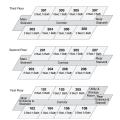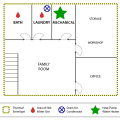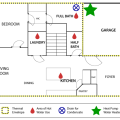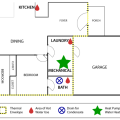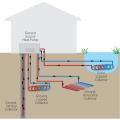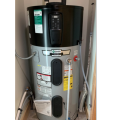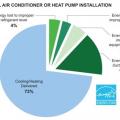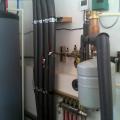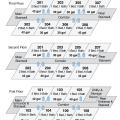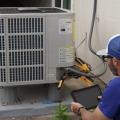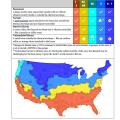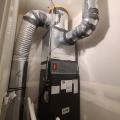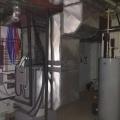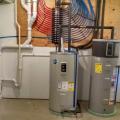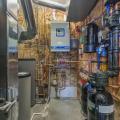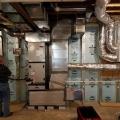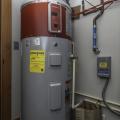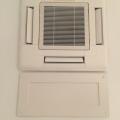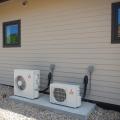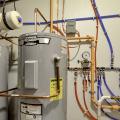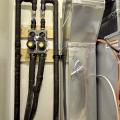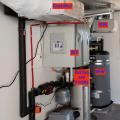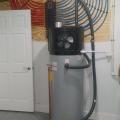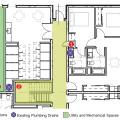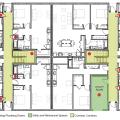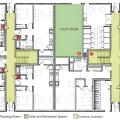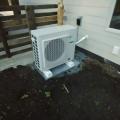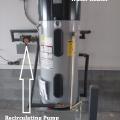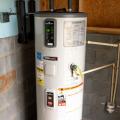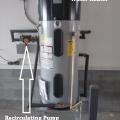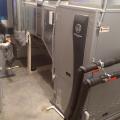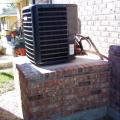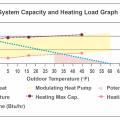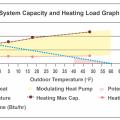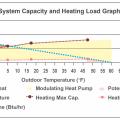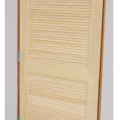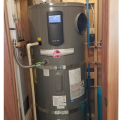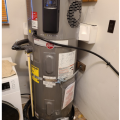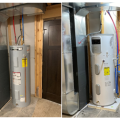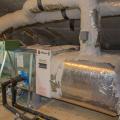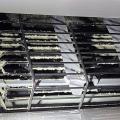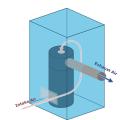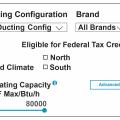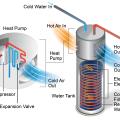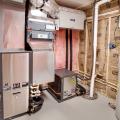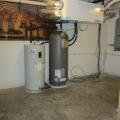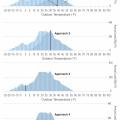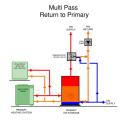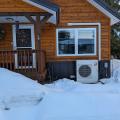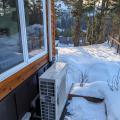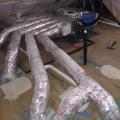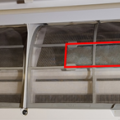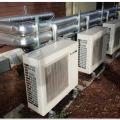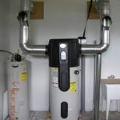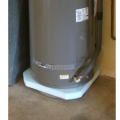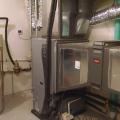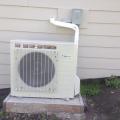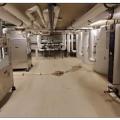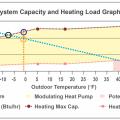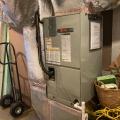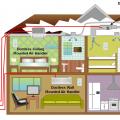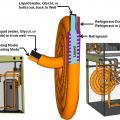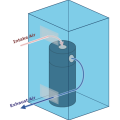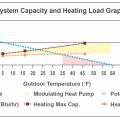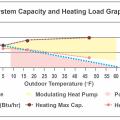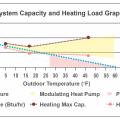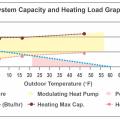Showing results 1 - 163 of 163
Right: dedicated tank connections for HPWH inlet and outlet provide hydraulic separation
These schematics illustrate temporary deployment locations for probes during the commissioning process; these probes connect to smartphone commissioning applications.
A central heat pump water heating system with a parallel loop tank temperature maintenance configuration uses a multi pass heat pump water heater to provide all the heat for hot water circulation temperature maintenance.
A central heat pump water heating system with a parallel loop tank temperature maintenance configuration uses a multi-pass heat pump water heater to provide all the heat for hot water circulation temperature maintenance
A central heat pump water heating system with a temperature maintenance swing tank configuration uses the water from the primary storage tank to provide most of the heat for hot water circulation temperature maintenance
A cool room should have low enough heat gains to be easily cooled by a small single-zone cooling system such as a mini-split or a window air-conditioner as shown here
A ducted minisplit heat pump is hidden in the ceiling of this centrally located room with short duct runs to the registers located on each wall of the room.
A ductless heat pump is hidden behind a wall outcropping above the hallway ceiling.
A foaming cleaner is used to clean the coils inside this ductless indoor unit; a mini-split bib surrounds the unit to contain overspray and drips
A foaming sprayer and mini-split bib are required to properly clean this ductless wall-mounted indoor unit
A ground source heat pump with an open-loop piping system using vertical injection and recharge
A ground-source heat pump has the same components as a standard air-to-air heat pump except that the liquid-to-refrigerant heat exchanger coil is located inside rather than outside
A ground-source heat pump used a fluid flowing through pipe loops to draw heat from or discharge heat the ground to heat or cool the indoor space.
A ground-source heat pump with a closed-loop horizontal “Slinky™ “piping arrangement
A heat pump clothes dryer is a type of condensing clothes dryer that uses heat pump technology to efficiently dry clothes
A heat pump water heater has a small heat pump located on top of the tank which extracts heat from the surrounding air to create hot water.
A high-efficiency heat pump is installed in a closet within this home’s conditioned space.
A nitrogen pressure test was completed on this ductless mini-split heat pump using a digital manifold gauge.
A permanent awning prevents snow and overflowing ice dams from causing damage to HVAC equipment below.
A properly sized cold climate heat pump can meet 100% of a home’s heating load in nearly any location in the United States
A properly sized high-efficiency heat pump is located in conditioned space in a closet inside the home.
A single ductless heat pump heats and cools the country’s first DOE Zero Energy Ready certified manufactured home.
A small, single-zone cooling system such as this ductless mini-split heat pump can be a very effective way to provide emergency cooling with a low power draw on a backup power system.
A vacuum decay test is performed on this ductless mini-split heat pump using a digital micron gauge for accurate measurement; a deep vacuum is achieved quickly by using large diameter, vacuum-rated hoses, and removing valve cores
Air seal a heat pump or air conditioner air handler cabinet at all seams, holes, and junctions
Alternative locations of heat pump water heaters in a hypothetical multifamily building using a cluster deployment showing numerous possible deployment options including clusters consisting of pairs on the same floor or on different floors
Because heat pump clothes dryers recycle the hot air in the drum rather than venting it, they use 70% less energy than conventional electric clothes dryers while drying clothes in the same amount of time
By plotting the heating capacities at -4°F and 5°F and drawing a line between them, the capacity at 0°F can be estimated
Central heat pump water heaters like this fully packaged system provide efficient, reliable domestic hot water for multifamily buildings; storage tanks are within the enclosure, and the heat pump is seen just outside.
Climate Zones Where a Heat Pump Water Heater can be Installed in Unconditioned Space
Cold-climate heat pumps can provide heating and cooling even in climate zone 7; this home retained a fuel oil boiler system for backup on the coldest days.
Condensate from this heat pump water heater is routed to a nearby floor drain, shared with the condensate lines from a condensing gas furnace and an air conditioning coil
Ductless indoor units like this one are controlled individually by handheld remote controllers.
Floorplan of a heat pump water heater located in a closet in an exterior corridor or breezeway rather than within the thermal envelope of a multifamily dwelling unit
Floorplan of a heat pump water heater located in a closet in an interior corridor rather than within the thermal envelope of a multifamily dwelling unit
Floorplan of a heat pump water heater located in an interior closet with active (ducted) ventilation
Floorplan of a heat pump water heater located in an interior closet with passive ventilation
Floorplan of a hypothetical multifamily building showing corridors and stairwells
Floorplan of a hypothetical multifamily building with hot water First Hour Rating (FHR) requirements (in gallons) noted for each dwelling unit
Floorplan of heat pump water heater located in an exterior closet with transfer grilles in the exterior wall or a louvered door to allow ventilation
Heat pump water heater is installed in the interior closet of a multifamily dwelling unit
In heating mode, split system heat pumps absorb heat from the outside air and “pump” that heat to the indoor air handler unit, which releases it to the inside air.
Most residential heat pumps are installed incorrectly and with energy-wasting faults.
Passive venting options for a heat pump water heater located in a closet or small room include: a fully louvered door, high and low transfer grilles, or a high transfer grille with a 0.75-inch door undercut
Pipe insulation helps retain heat in the pipes which provide hot water from the air-to-water heat pump for domestic hot water and space heating.
Possible locations of heat pump water heater (HPWH)s in a hypothetical multifamily building using a one-to-one deployment of one HPWH per apartment
Possible locations of heat pump water heaters in a hypothetical multifamily building using a cluster deployment where pairs of dwelling units share a heat pump water heater
Quality installation and commissioning are critical to optimizing heat pump performance.
Recommended Installation Locations for a Heat Pump Water Heater Based on the Climate Zone of Home
Right - Ducts and heat pump cabinet are properly sealed with mastic, high MERV filter is installed, and duct and refrigerant lines are air sealed at ceiling.
Right - The geothermal heat pump provides hot water for radiant floor heating, domestic hot water, and the air handler for space conditioning upstairs.
Right - The home’s ground source heat pump preheats water for the air source heat pump water heater.
Right - The home’s high-efficiency gas boiler provides domestic hot water as well as in-floor radiant heat, while a high-efficiency heat pump provides cooling and a secondary source of heating.
Right - The precast insulated concrete walls of the basement provide a conditioned space for the high-efficiency (18 SEER, 9.5 HSPF) air-source heat pump, with its variable-speed fan, five-stage compressor, and MERV 11 filter.
Right - This 80-gallon heat pump water heater is ducted to pull heat from outside air drawn from the south side of the house and to exhaust cooled air outside on the north side of the house to efficiently heat water without impacting room temperatures.
Right - This ductless minisplit uses a ceiling-mounted rather than wall-mounted air handler.
Right - Two high-efficiency (12 HSPF, 26 SEER) ductless mini-split heat pumps heat and cool the home.
Right – A dehumidifier is installed next to the central heat pump’s air handler to pull air from the supply plenum, remove moisture, and re-introduce the air downstream in the supply plenum; this setup removes moisture efficiently.
Right – A ground-source heat pump provides space heating and domestic hot water.
Right – Adequate space is provided near the air handler for the water lines of this ground-source heat pump.
Right – An air-to-water heat pump efficiently provides hot water for radiant floor heating.
Right – An air-to-water heat pump provides water and space heating while a heat recovery ventilator provides fresh air that is filtered by the HEPA filter.
Right – Hot water from this heat pump water heater is distributed efficiently to each hot water use in the home through a central manifold via PEX piping.
Right – Possible Heat Pump Water Heater Locations on a Multifamily Floorplan including an interior corridor, eight apartments, and meeting rooms
Right – Possible Heat Pump Water Heater Locations on a Multifamily Floorplan including interior corridor closets, under-stair closes, and utility rooms
Right – Possible Heat Pump Water Heater Locations on Full Plate Floorplan in a Multifamily Building
Right – The double compressor unit supplies multiple interior minisplit heat pump heads.
Right – The ductless minisplit in this open area is installed in the ceiling rather than on a wall.
Right – The exterior unit of the mini-split heat pump is installed on blocks on a concrete pad to keep the equipment elevated above mud and water runoff.
Right – The heat pump water heater is equipped with a recirculating pump to push hot water to distant fixtures.
Right – This heat pump water heater is equipped with a recirculation pump to speed hot water to distant faucets.
Right – This home’s HVAC system consists of a ground source heat pump that provides heating and cooling with a rated efficiency of 5.0 COP.
Right – This HRV is ducted separately from the home’s ductless heat pumps to provide filtered fresh air to sleeping and living areas and to exhaust stale air from the bathrooms and laundry.
Right – This HVAC condensing unit is elevated on a raised-slab
Right (decent): For a relatively high-capacity ccASHP sized per Approach 3 or 4 to meet nearly 100% of the heating load, this heat pump’s modulating zone has a decent overlap with the home’s heating load line, reducing short-cycling.
Right: Maintenance valves are installed at the inlet and outlet of this central heat pump water heater
Right: Sized per Approach 1, this heat pump will have minimal short-cycling; since sized using Approach 1, it will require backup heat when temp is below 30°F but could still contribute significant heating down to heating design temp (-6°F) and lower
Right: Sized per Approach 3 or 4, this heat pump’s modulating zone has a large overlap with the home’s heating load line, resulting in minimal short-cycling; the unit may require a small amount of backup heat during the very coldest hours of winter.
Right: Sized per Approach 3, this heat pump’s modulating zone has a large overlap with the home’s heating load line; it will require backup heating but could still contribute significant heating for all hours of the heating season
Right: This closet door for a heat pump water heater is louvered to allow warm air to enter and exhaust air to leave the closet
Right: This heat pump water heater is in a basement within the thermal boundary but not actively conditioned. It has over 770 ft² of space with easy access to the control panel and clearance for airflow to the air intake (top) and exhaust (side)
Right: This heat pump water heater is installed in a garage next to the furnace where there is a lot of space for accessing the unit, and for intake and exhaust; a foam pad insulates the base; the condensate line is correctly drained and pipe insulation
Right: This heat pump water heater is installed in a laundry room with enough space for the control panel and vents to be clear of obstructions; The HPWH can use heat from the dryer to heat water, but the seismic straps should be lower
Right: This heat pump water heater is installed in a small space so the, intake air is ducted from an adjacent room; the water heater since on a pad of foam insulation and has a good drain line configuration but the waterpipes lack insulation
Right: This heat pump water heater is installed in a utility closet where it can use heat from the clothes washer and heat pump clothes dryer and has access to a floor drain for condensate
Size comparison between two 50-gallon water heaters: a traditional electric-resistance-only water heater on the left and a heat pump water heater on the right
The air handler of the air-to-water heat pump is equipped with a very high efficiency air filter and a damper-controlled fresh air intake.
The blower wheel (fan) on this ductless wall-mounted indoor unit has accumulated dust and mold - a common issue for this design.
The cool exhaust air from this heat pump water heater is ducted out of the room, inducing warmer intake air to enter through a wall grille
The ductless air handler of a ductless heat pump can be mounted above the ceiling so that only the register is visible
The Energy Guide label on this heat pump water heater shows a first hour rating of 60 gallons; the low Estimated Yearly Energy Cost of $121 reflects the HPWH’s high Uniform Energy Factor (UEF) of (not shown on label)
The filter access panel on this vertical upflow air handler is located between the return ductwork below and the coils above.
The heat pump water heater’s evaporator fan provides enough air movement for active ventilation of a small room when the exhaust is ducted; intake air enters passively through a wall grille
The high-efficiency air-to-air heat pump is set in an overflow pan with an emergency shut off sensor in case the condensate tube were to clog and cause condensate to fill up the pan.
The high-efficiency mini-split heat pump provides cooling and heating; a drain pipe carries condensate away to a location that meets local code requirements.
The NEEP Cold Climate Air Source Heat Pump List allows users to search, sort, and filter for cold climate heat pumps by brand, model, product type, and ducting configuration; an advanced search provides helpful resources for sizing to the heating load
The small heat pump located on top of the tank on a heat pump water heater extracts heat from the surrounding air to create hot water
The ultra-efficient air-to-water heat pump draws heat from the outside air to heat inside room air in winter and domestic hot water year-round.
The ultra-efficient ground source heat pump (COP 4.4) delivers conditioned air throughout the home via ducts; an ERV provides fresh air to the system.
The ultra-efficient ground-source heat pump provides the home with forced-air heating and cooling, and hot water.
The very high efficiency (4.7 COP) ground-source heat pump provides hot water to a tank for radiant floor heat and domestic hot water.
These plots compare sizing approaches in terms of the approximate annual heating load a heat pump might carry throughout the year for a hypothetical home in Minneapolis, MN.
This “high static ducted cassette” heat pump system is similar to a traditional centrally ducted system, serving several areas of a home from one indoor unit
This central heat pump water heating system with a hot water circulation loop that returns to the primary storage tank relies on a single pass heat pump to provide both primary DHW heating and hot water circulation temperature maintenance
This central heat pump water heating system with a hot water circulation loop that returns to the primary storage tank relies on a multi pass heat pump to provide both primary DHW heating and hot water circulation temperature maintenance
This cold-climate heat pump can meet >90% of this home’s heating needs, even in Cordova, Alaska.
This cold-climate heat pump provides heat at 77% capacity at 5°F, and 57% of capacity at -5 °F.
This cold-climate heat pump provides heating and cooling for a home in Cordova, Alaska.
This ducted mini-split heat pump was installed in the unvented, conditioned attic and ducted with short duct runs to several nearby rooms.
This ductless wall-hung indoor unit has supplemental air filters (outlined in red), which only filter a portion of the airflow; most of the air bypasses the supplementary filters and only passes through the standard mesh filters.
This fully packaged/skid-mounted central heat pump water heating system was shipped to the building on a truck and craned into location
This fully specified central heat pump water heating system has four individual outdoor heat pump units plumbed in parallel to indoor storage tanks
This heat pump water heater has been fitted with ducts to exhaust its waste cooling into the occupied living area
This Heat Pump Water Heater has Pipe insulation installed on the hot water line (on left) and on the cold water line (on right)
This heat pump water heater is centrally located in a laundry room so that all hot water uses are less than 15 feet from the tank.
This Heat Pump Water Heater is Sitting on an Insulation Pad to Reduces Heat Losses
This home is equipped with an ultra-efficient (COP 5.7) ground source heat pump, which also provides domestic hot water that is stored in a tank.
This home’s ultra-efficient ground-source heat pump provides hot water for space heating as well as domestic hot water for the 50-gallon storage tank.
This is the compact outside unit for an ultra-efficient air-to-water heat pump (COP 4.1) that provides space heating and domestic hot water.
This mechanical room contains both the storage tanks (right) and heat pumps (left) of a central heat pump water heating system
This multi-split heat pump system incorporates several indoor units connected to just one outdoor unit; the indoor units include a wall-mounted unit, floor-mounted, ceiling cassette, and mini-air handler.
This packaged central heat pump water heating system has the heat pumps on the exterior of the blue enclosure, and the storage tanks, temperature maintenance equipment, mixing valve, and control modules on the inside
This plot shows a heat pump’s minimum and maximum cooling capacities overlaid with a home’s cooling load line, allowing a designer to assess how well-suited the equipment is for the specific home.
This plot shows a heat pump’s minimum and maximum heating capacities overlaid with a home’s heating load line as well as the annual heating load hours for the home, allowing a designer to assess how well-suited the equipment is for the specific home.
This plot shows a heat pump’s minimum and maximum heating capacities overlaid with a home’s heating load line, allowing a designer to assess how well-suited the equipment is for the specific home.
This plot shows a heat pump’s minimum and maximum heating capacities overlaid with a home’s heating load line, allowing a designer to assess how well-suited the equipment is for the specific home.
This retrofit central heat pump water heater system utilizes the existing water heater as a swing tank to provide temperature maintenance for the hot water circulation loop
This single-zone mini-split ductless heat pump has only one indoor wall-mounted unit and one outdoor unit.
This traditional centrally ducted heat pump heats and cools the entire home through a network of ducts.
This upflow air handler for a traditional heat pump has an electric resistance auxiliary heating element located at the top of the unit (circled in red).
Three-zone ductless mini-split system consisting of two wall-mounted and one ceiling-mounted indoor ductless units and one outdoor unit
Three-zone mini-split system consisting of one wall-mounted ductless unit, one ceiling-mounted ductless unit, and one ducted indoor unit, all connected to one outdoor unit
Types of heat pump water heaters commonly used in central heat pump water heating systems include single pass units, multi pass units, and integrated units
Typical coaxial coil (liquid-to-refrigerant heat exchanger) used in a ground-source heat pump
Wall grilles installed high and low on the wall of the heat pump water heater closet allow passive ventilation of a small room with warmer air coming in at the top and cooler exhaust air exiting at the bottom of the wall
Wrong: HPWH inlet and outlet are piped to mixing valve inlet and DCW make up, driving erratic HPWH and mixing valve behavior
Wrong: Not enough space was left in the floorplans for both the heat pump water heater and a duct elbow to be attached to the right side of the water heater (the orange circle outlines the tank; the rectangle shows the space needed for the duct)
Wrong: Sized per Approach 1 or 2, this heat pump’s modulating zone has a small overlap with the home’s heating load line, resulting in a large amount of short-cycling; the unit will require backup heat when the temperature is below 25°F
Wrong: Sized per Approach 3, there is minimal overlap between this heat pump’s modulating zone and the home’s heating load line, causing excessive short-cycling; it will require backup heat and may not contribute significantly at temperatures below 5°F
Wrong: Sized per Approach 3, there is small overlap between this heat pump’s modulating zone and the home’s heating load line, resulting in excessive short-cycling; it will require backup heat when the temperature is below 5°F
Wrong: The exhaust air from one heat pump water heater is blowing into the intake of the heat pump water heater next to it
Wrong: This heat pump is oversized even for Approach 4, and its modulating zone has a small overlap with the home’s heating load line, resulting in a large amount of short-cycling.
